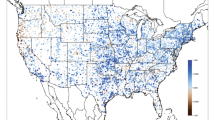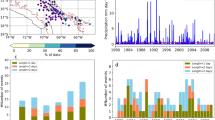Abstract
We study the influence of synoptic scale atmospheric circulation on extreme daily precipitation across the United Kingdom, using observed time series from 689 rain gauges. To this end we employ a statistical model, that uses airflow strength, direction and vorticity as predictors for the generalised extreme value distribution of monthly precipitation maxima. The inferred relationships are connected with the dominant westerly flow, the orography, and the moisture supply from surrounding seas. We aggregated the results for individual rain gauges to regional scales to investigate the temporal variability of extreme precipitation. Airflow explains a significant fraction of the variability on subannual to decadal time scales. A large fraction of the especially heavy winter precipitation during the 1980s and 1990s in north Scotland can be attributed to a prevailing positive phase of the North Atlantic Oscillation. Our statistical model can be used for statistical downscaling and to validate regional climate model output.







Similar content being viewed by others
Notes
Cubic splines are piecewise third order polynomial functions, which are smoothly connected at a set of knots (i.e. the function and its first and second derivatives are continuous). Natural splines require vanishing curvature at the beginning and end of the data interval. With only one knot (here in the centre of the data interval), a natural cubic spline has two degrees of freedom.
Often, the estimators for μ, σ and ξ are correlated, and compensate for each other. E.g. a low estimate for σ could partly compensate for a high estimate of ξ, leaving some quantiles basically unchanged. In this context, only the quantiles have a unique and physically-relevant meaning.
This, however, does not imply that airflow in Kinlochewe almost always flows from the west.
The density of data points for low airflow strength values is higher than for high strength values. Consequently also the probability to observe high precipitation values decreases with higher strength. This creates a spurious impression of a negative relationship between airflow strength and precipitation. For a general discussion refer to Maraun et al. (2009b).
Using the relation E[GEV(x;μ, σ, ξ)] = μ − σ/ξ(1 − Γ(1 − ξ)) (Embrechts et al. 1997), where Γ() is the Gamma function
Due to the smoothing necessary to obtain meaningful coherence estimates, coherence peaks are smeared out to neighbouring frequencies, see e.g. Brockwell and Davis (1991).
References
ABI (2007). Summer floods 2007: learning the lessons. Association of British Insurers
Akaike H (1973) Information theory and an extension of the maximum likelihood principle. In: Petrov B, Csaki F, (eds) 2nd International Symposium on information theory, Budapest, Akademie Kiade, pp 267–281
Alexander LV, Zhang X, Peterson TC, Caesar J, Gleason B, Tank AMGK, Haylock M, Collins D, Trewin B, Rahimzadeh F, Tagipour A, Kumar KR, Revadekar J, Griffiths G, Vincent L, Stephenson DB, Burn J, Aguilar E, Brunet M, Taylor M, New M, Zhai P, Rusticucci M, Vazquez-Aguirre JL (2006) Global observed changes in daily climate extremes of temperature and precipitation. J Geophys Res 111:D05109
Braun S, Rotunno R, Klemp J (1999) Effects of coastal orography on landfalling cold fronts. Part II: effects of surface friction. J Atmos Sci 56:3366–3384
Brockwell PJ, Davis RA (1991) Time series: theory and models. Springer, Heidelberg
Chandler RE, Wheater HS (2002) Analysis of rainfall variability using generalized linear models: a case study from the west of Ireland. Water Resour Res 38(10):1192
Christensen JH, Hewitson B, Busuioc A, Chen A, Gao X, Held I, Jones R, Kolli RK, Kwon WT, Laprise R, Rueda VM, Mearns L, Menéndez CG, Räisänen J, Rinke A, Sarr A, Whetton P (2007). Climate change 2007: the physical science basis. Contribution of Working Group I to the Fourth Assessment Report of the Intergovernmental Panel on climate change. Regional Climate Projections. Cambridge University Press, Cambridge, UK and New York, NY, USA
Coles S (2001). An introduction to statistical modeling of extreme values. Springer Series in statistics, Springer, London
Conway D, Wilby RL, Jones PD (1996) Precipitation and air flow indices over the British Isles. Clim Res 7(2):169–183
Ekström M, Fowler HJ, Kilsby CG, Jones PD (2005) New estimates of future changes in extreme rainfall across the UK using regional climate model integrations. 2. Future estimates and use in impact studies. J Hydrol 300:234–251
Embrechts P, Klüppelberg C, Mikosch T (1997) Modelling Extremal events for insurance and finance. Applications in mathematics, Springer, Berlin
Fowler HJ, Kilsby CG (2003) Implications of changes in seasonal and annual extreme rainfall. Geophys Res Lett 30(13):1720. doi:10.1029/2003GL017327
Fowler HJ, Ekström M, Kilsby CG, Jones PD (2005) New estimates of future changes in extreme rainfall across the UK using regional climate model integrations. 1. Assessment of control climate. J Hydrol 300:212–233
Fowler HJ, Blenkinsop S, Tebaldi C (2007) Linking climate change modelling to impacts studies: recent advances in downscaling techniques for hydrological modelling. Int J Climatol 27:1547–1578
Friederichs P, Hense A (2007) Statistical downscaling of extreme precipitation events using censored quantile regression. Mon Weather Rev 135(6):2365–2378
Hall J, Sayers P, Dawson R (2005) National-scale assessment of current and future flood risk in England and Wales. Nat Hazard 36(1-2):147–164
Haylock MR, Gawley GC, Harpham C, Wilby RL, Goodess CM (2006) Downscaling heavy precipitation over the UnitedKingdom: a comparison of dynamical and statistical methods and their future scenarios. Int J Climatol 26(10):1397–1415
Hegerl GC, Zwiers FW, Braconnot P, Gillett NP, Luo Y, Marengo Orsini JA, Nicholls N, Penner JE, Stott PA (2007) Climate change 2007: the physical science basis. Contribution of Working Group I to the Fourth Assessment Report of the Intergovernmental Panel on climate change. Understanding and attributing climate change. Cambridge University Press, Cambridge, UK and New York, NY, USA.
Jenkinson A, Collison F (1977) An initial climatology of gales over the north sea. Technical report, Synoptic Climatology Branch Memorandum No. 62, Meteorological Office, Bracknell.
Jones P, Hulme M, Briffa K (1993) A comparison of lamb circulation types with an objective classification scheme. Int J Climatol 13:655–663
Katz RW, Parlange MB, Naveau P (2002) Statistics of extremes in hydrology. Adv Water Resour 25(8-12):1287–1304
Leadbetter MR, Lindgren G, Rootzen H (1983) Extremes and related properties of random sequences and processes. Springer Series in Statistics, Springer, New York
Maraun D, Osborn TJ, Gillett NP (2008) United Kingdom daily precipitation intensity: improved early data, error estimates and an update from 2000 to 2006. Int J Climatol 28(6):833–842. doi:10.1002/joc.1672
Maraun D, Rust HW, Osborn TJ (2009a) The annual cycle of heavy precipitation across the UK: a model based on extreme value statistics. Int J Climatol. doi:10.1002/joc.1811
Maraun D, Rust HW, Osborn TJ (2009b) Synoptic airflow and UK daily precipitation extremes. Development and validation of a vector generalised model. Extremes (submitted)
Marshall J, Kushnir Y, Battisti D, Chang P, Czaja A, Dickson R, Hurrell J, McCartney M, Saravanan R, Visbeck M (2001) North Atlantic climate variability: phenomena, impacts and mechanisms. Int J Climatol 21:1863–1898
McCullagh P, Nelder JA (1983) Generalized linear models. Chapman and Hall, London
Meehl GA, Stocker TF, Collins WD, Friedlingstein P, Gaye AT, Gregory JM, Kitoh A, Knutti R, Murphy JM, Noda A, Raper SCB, Watterson IG, Weaver AJ, Zhao ZC (2007). Climate change 2007: the physical science basis. Contribution of Working Group I to the Fourth Assessment Report of the Intergovernmental Panel on climate change. Global climate projections. Cambridge University Press, Cambridge, UK and New York, NY, USA
Naveau P, Nogaj M, Ammann C, Yiou P, Cooley D, Jomelli V (2005) Statistical methods for the analysis of climate extremes. C R Geosci 337(10-11):1013–1022
Osborn TJ (2004) Simulating the winter North Atlantic Oscillation: the roles of internal variability and greenhouse gas forcing. Clim Dyn 22:605–623
Osborn TJ, Jones PD (2000) Air flow influences on local climate: observed United Kingdom climate variations. Atmos Sci Lett 1:62–74
Osborn T, Conway D, Hulme M, Gregory J, Jones P (1999) Air flow influences on local climate: observed and simulated mean relationships for the United Kingdom. Clim Res 13:173–191
Osborn TJ, Hulme M, Jones PD, Basnett TA (2000) Observed trends in the daily intensity of United Kingdom precipitation. Int J Climatol 20:347–364
Papoulis A (1991) Probability, random variables and stochastic processes, 3rd edn. McGraw-Hill, New York
Press WH, Teukolsky SA, Vetter WT, Flannery BP (1992) Numerical recipes in C, 2nd edn. Cambridge University Press, Cambridge
Roe G (2005) Orographic precipitation. Annu Rev Earth Planet Sci 33:645–671
Rust HW (2009) The effect of long-range dependence on modelling extremes with the generalised extreme value distribution. Eur Phys J Spec Top, pp 91–97
Rust HW, Maraun D, Osborn TJ (2009) Modelling seasonality in extreme rainfall: a UK case study. Eur Phys J Spec Top, pp 99–111
Scaife AA, Folland CK, Alexander LV, Moberg A, Knight JR (2008) European climate extremes and the North Atlantic Oscillation. J Clim 31(1):72–83
Trenberth KE, Dai A, Rasmussen RM, Parsons DB (2003) The changing character of precipitation. Bull Am Meteorol Soc 84:1205–1217
Trenberth KE, Jones PD, Ambenje P, Bojariu R, Easterling D, Klein Tank A, Parker D, Rahimzadeh F, Renwick JA, Rusticucci M, Soden B, Zhai P (2007) Climate change 2007: the physical science basis. Contribution of Working Group I to the Fourth Assessment Report of the Intergovernmental Panel on climate change. Observations: surface and atmospheric climate change. Cambridge University Press, Cambridge, UK and New York, NY, USA
Vrac M, Naveau P (2007) Stochastic downscaling of precipitation: from dry events to heavy rainfalls. Water Resour Res 43(7):W07402
Wigley TML, Lough JM, Jones PD (1984) Spatial patterns of precipitation in England and Wales and a revised, homogeneous England and Wales precipitation series. J Climatol 4:1–25
Wilby RL (1998) Statistical downscaling of daily precipitation using daily airflow and seasonal teleconnection indices. Clim Res 10(3):163–178
Wilby RL, O’Hare G, Barnsley N (1997) The North Atlantic Oscillation and British Isles climate variability. Weather 52:266–276
Wilby RL, Tomlinson OJ, Dawson C (2003) Multi-site simulation of precipitation by conditional resampling. Clim Res 23(3):183–194
Wilks DS (2006) Statistical Methods in the Atmospheric Sciences, 2 edn. Academic Press, San Diego
Yee TW, Wild CJ (1996) Vector generalized additive models. J. R. Stat. Soc. B 58:481–493
Yee TW, Stephenson AG (2007) Vector generalized linear and additive extreme value models. Extremes 10:1–19
Acknowledgements
Douglas Maraun received funding from the NERC Flood Risk From Extreme Events (FREE) programme (NE/E002412/1), and Henning Rust from the Collaborative Research Centre SFB 555 of the DFG and the GIS project REGYNA. We acknowledge travel grants from the British Council (ARC 1291) and the German Academic Exchange Service (DAAD, D/07/09988). We would like to thank Thomas Yee for his VGAM package, and his continual help with all questions regarding the software. We also thank Jonathan Tawn, Olivier Mestre, Alexey Karpechko and Ian Renfrew for helpful and inspiring discussions and advice. Part of the software is based on the EVD package by Alec Stephenson.
Author information
Authors and Affiliations
Corresponding author
Electronic supplementary material
Below is the link to the electronic supplementary material.
Rights and permissions
About this article
Cite this article
Maraun, D., Osborn, T.J. & Rust, H.W. The influence of synoptic airflow on UK daily precipitation extremes. Part I: Observed spatio-temporal relationships. Clim Dyn 36, 261–275 (2011). https://doi.org/10.1007/s00382-009-0710-9
Received:
Accepted:
Published:
Issue Date:
DOI: https://doi.org/10.1007/s00382-009-0710-9




